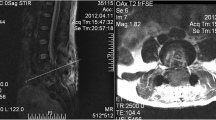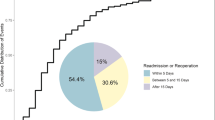Abstract
Purpose
Spinal epidural haematoma (SEH) is a common complication after lumbar spinal decompression surgery, and symptomatic SEH usually causes devastating neurological deficits. Although different risk factors for post-operative SEH have been reported, few studies focused on patients’ laboratory tests. The purpose of this study was to analyze the incidence of symptomatic SEH following lumbar spinal surgery, as well as identify the risk factors for it.
Methods
Patients who underwent posterior lumbar spinal decompression surgery between January 2010 and August 2016 were included in this study and their medical records were retrospectively reviewed. Those who developed post-operative symptomatic SEH after the surgery were identified. The risk factors for SEH were analyzed by univariate and multivariate regression analysis.
Results
In total, 2715 patients were included in this study and 31 (1.14%) were identified with post-operative symptomatic SEH. Of these patients, 19 were males and 12 were females, with an average age of 59.39 ± 11.66 years. After multivariate logistic regression analysis, low serum calcium level (P = 0.025), blood type A (P = 0.04), increased estimated blood loss (P = 0.032), prolonged surgical duration (P = 0.018), and decreased post-operative globulin (P = 0.016) were identified as the independent risk factors for post-operative SEH following lumbar spinal surgery. Furthermore, prolonged surgical duration (odds ratio = 3.105) was the strongest risk factor for SEH.
Conclusion
Based on a large population investigation, the incidence of symptomatic SEH following lumbar spinal decompression surgery was 1.14%. Blood type A, increased estimated blood loss, and prolonged surgical duration were identified as the independent risk factors for post-operative SEH while two new risk factors, including low serum calcium level and decreased post-operative globulin, were firstly identified in this study.
Similar content being viewed by others
References
Mirzai H, Eminoglu M, Orguc S (2006) Are drains useful for lumbar disc surgery? A prospective, randomized clinical study. J Spinal Disord Tech 19:171–177
Sokolowski MJ, Garvey TA, Perl J 2nd, Sokolowski MS, Cho W, Mehbod AA, Dykes DC, Transfeldt EE (2008) Prospective study of postoperative lumbar epidural hematoma: incidence and risk factors. Spine 33:108–113
Modi HN, Lee DY, Lee SH (2011) Postoperative spinal epidural hematoma after microscopic lumbar decompression: a prospective magnetic resonance imaging study in 89 patients. J Spinal Disord Tech 24:146–150
Aono H, Ohwada T, Hosono N, Tobimatsu H, Ariga K, Fuji T, Iwasaki M (2011) Incidence of postoperative symptomatic epidural hematoma in spinal decompression surgery. J Neurosurg Spine 15:202–205
Amiri AR, Fouyas IP, Cro S, Casey AT (2013) Postoperative spinal epidural hematoma (SEH): incidence, risk factors, onset, and management. Spine J: Off J North Am Spine Soc 13:134–140
Kou J, Fischgrund J, Biddinger A, Herkowitz H (2002) Risk factors for spinal epidural hematoma after spinal surgery. Spine 27:1670–1673
Cabana F, Pointillart V, Vital J, Senegas J (2000) Postoperative compressive spinal epidural hematomas. 15 cases and a review of the literature. Rev Chir Orthop Reparatrice Appar Mot 86:335–345
Awad JN, Kebaish KM, Donigan J, Cohen DB, Kostuik JP (2005) Analysis of the risk factors for the development of post-operative spinal epidural haematoma. J Bone Joint Surg Br Vol 87:1248–1252
Raasck K, Habis AA, Aoude A, Simoes L, Barros F, Reindl R, Jarzem P (2017) Spontaneous spinal epidural hematoma management: a case series and literature review. Spinal Cord Series Cases 3:16043
Kao FC, Tsai TT, Chen LH, Lai PL, Fu TS, Niu CC, Ho NY, Chen WJ, Chang CJ (2015) Symptomatic epidural hematoma after lumbar decompression surgery. Eur Spine J 24:348–357
Yamada K, Abe Y, Satoh S, Yanagibashi Y, Hyakumachi T, Masuda T (2015) Large increase in blood pressure after Extubation and high body mass index elevate the risk of spinal epidural hematoma after spinal surgery. Spine 40:1046–1052
Kazui S, Minematsu K, Yamamoto H, Sawada T, Yamaguchi T (1997) Predisposing factors to enlargement of spontaneous intracerebral hematoma. Stroke 28:2370–2375
Groen RJ, Ponssen H (1990) The spontaneous spinal epidural hematoma. A study of the etiology. J Neurol Sci 98:121–138
Huang LH, Ke XH, Sweeney W, Tam JP (1989) Calcium binding and putative activity of the epidermal growth factor domain of blood coagulation factor IX. Biochem Biophys Res Commun 160:133–139
Rodgers GM, Cong JY, Goll DE, Kane WH (1987) Activation of coagulation factor V by calcium-dependent proteinase. Biochim Biophys Acta 929:263–270
Sinha D, Seaman FS, Walsh PN (1987) Role of calcium ions and the heavy chain of factor XIa in the activation of human coagulation factor IX. Biochemistry 26:3768–3775
Miale JB (1949) The role of staphylocoagulase in blood coagulation; the reaction of staphylocoagulase with coagulase-globulin to form coagulase-thrombin. Blood 4:1039–1048
Miale JB (1952) The role of coagulase-globulin in blood coagulation and its thromboplastic action. Am J Clin Pathol 22:218–230
Funding
This work is supported by the Department of Science and Technology Program of Jiangxi Province, China (No. 20162BCB22022, 20162BCB23057).
Author information
Authors and Affiliations
Corresponding author
Ethics declarations
Conflict of interest
The authors declare that they have no conflict of interest.
Ethical approval
This study was approved by the medical research ethics committee of our hospital.
Informed consent
Informed consent was obtained from all individual participants included in the study.
Rights and permissions
About this article
Cite this article
Liu, JM., Deng, HL., Zhou, Y. et al. Incidence and risk factors for symptomatic spinal epidural haematoma following lumbar spinal surgery. International Orthopaedics (SICOT) 41, 2297–2302 (2017). https://doi.org/10.1007/s00264-017-3619-7
Received:
Accepted:
Published:
Issue Date:
DOI: https://doi.org/10.1007/s00264-017-3619-7




